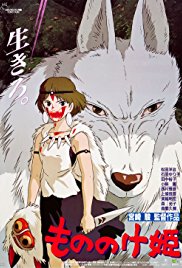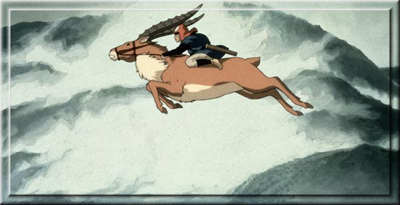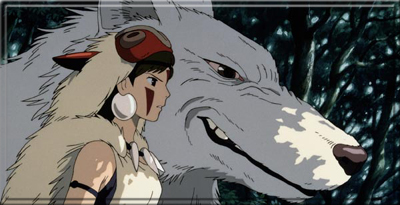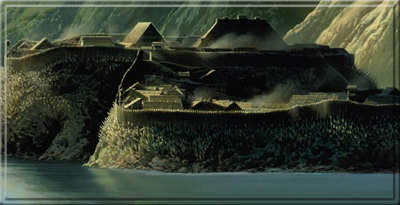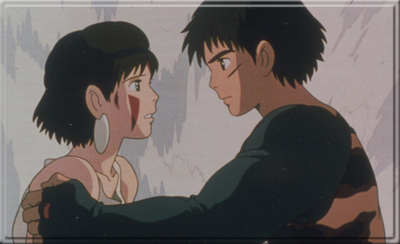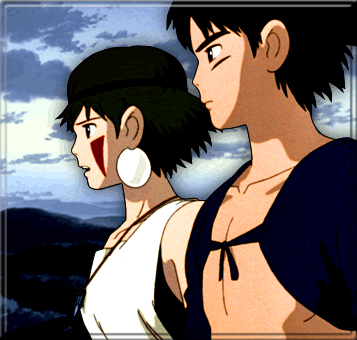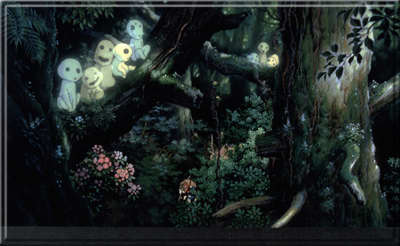1. See Discussion Questions for Use With any Film that is a Work of Fiction.
2. The film opens with a long shot of mist-laden mountains and the words “Long ago, this country was covered by deep forests in which, from ancient times, there lived the gods.” What does this tell us?
Suggested Response:
It tells us that the story is not of our time and place but exists in a mythical time and place.
3. The fact that the iron bullet poisons the boar god and turns him into a demon is a symbol. What does it mean in the context of the story?
Suggested Response:
Iron and the civilization based on iron is alien and destructive to the gods of the forest, or, in other words, civilization based on iron is repugnant to nature.
4. “Princess Mononoke” is the most popular Japanese movie ever made. This fact indicates that its story relates to important issues affecting Japanese society. Some of these are relevant to people the world over. What are they?
Suggested Response:
Good responses should include some of the following concepts: (1) We are concerned about our abuse of the environment. (2) The proper male role model is not the destructive entrepreneur or the samurai out for his own enrichment or glory, represented by Jiko-Bo, but rather the peacemaker who nurtures every well-meaning person that he meets, exemplified by Ashitaka. (Ashitaka helps everyone but Jiko-Bo. See also the character of Atticus Finch in To Kill A Mockingbird.) (3) There is a continuing recognition that the era of male domination and patriarchy is coming to a close and that women can become leaders. This story also calls into question pivotal myths of Japanese culture and society, such as reverence for the emperor, a view of history as a chronology of events at the imperial court and wars of the samurai, and the conviction that the Japanese are a homogeneous people living in harmony with nature ruled by a patriarchal elite.
5. At the end of the film, has a lasting peace has been achieved between the ironworks and the forest? Can they coexist?
Suggested Response:
There is no lasting peace but perhaps the forest and the ironworks can coexist. Ashitaka hopes so and will work for it. Some critics see this film as an argument that very different cultures can, or rather must, learn to live in the same space without losing their identities. This applies to both the international community and to groups of people within nations. See Anime from Akira to Princess Mononoke: Experiencing Contemporary Japanese Animation by Susan J. Napier, 2000, pp. 191 & 192.
6. Does this film have the classic “happy ending”?
Suggested Response:
No. San and Ashitaka cannot live together. There is no lasting peace between nature and civilization and we know that in the future nature will suffer further depredations by civilization. In the terms of the symbols of this movie, the forest and its gods (nature) will continue to be pushed back by the ironworks (civilization).
7. If you were to analyze this film in terms of its plot (i.e. setting, rising action, conflict and resolution) is there really a resolution?
Suggested Response:
The resolution is incomplete. See response to preceding two questions.
8. This film shows an animist view of nature. What is animism? Does anyone still believe it?
Suggested Response:
Animism is the belief that natural objects, natural phenomena, and the universe itself possess a spiritual dimension and can become gods. The beliefs of the ancient Greeks and Romans in which there was a god of the sea, a god of the winds, etc. was animist. Hinduism has strong elements of animism. The Japanese Shinto religion also believes that animate and inanimate objects, in addition to human beings, have a spiritual dimension. In many cultures people hold animist beliefs along with the beliefs of the major non-animist religions: Christianity, Buddhism, and Islam. Animism is still a vital force in the spiritual lives of many people.
9. This story can be seen as the tale of the quest of a hero. How is it like and unlike other hero myths that you know about? (Examples: Odysseus, Jason, Hercules, Luke Skywalker.)
Suggested Response:
Like all heroes, Ashitaka leaves his village on a quest. His quest is not for greatness but, like Odysseus, for survival. Like other heroes, Ashitaka undergoes challenges and by meeting them saves his community, although, for Ashitaka it is not the isolated and doomed community he came from. Instead, the community helped by Ashitaka represents all mankind. Note that Ashitaka is not cured of the curse by the Forest God until Ashitaka becomes instrumental in returning the Forest God’s head. This was the test that Ashitaka had to pass.
10. How is the role of women, as shown in this story, different than the view of women in traditional Japanese society?
Suggested Response:
The women in this story are strong and powerful leaders. Traditional Japanese society viewed the role of women as limited to serving men and family. The creator of this film, Hayao Miyazaki, intended to challenge this view of women when he wrote the script for this film.
11. What did the Wise Woman of the Emishi village mean when she said that Ashitaka must learn “to see with eyes unclouded by hate”?
Suggested Response:
Emotions such as anger, the desire for revenge, or hatred often blind us to reality, justice or what is really important.
12. In this movie, what did the Forest Spirit and the animal gods represent and what did Lady Eboshi and her ironworks represent?
Suggested Response:
The Forest Spirit and the animal gods represented nature. The inhabitants of the ironworks, led by Lady Eboshi, represented the forces of human development and progress.
13. What would be lost if the world was completely developed and consisted of nothing but cities, housing developments, shopping malls, roads, office buildings, farms, and factories?
Suggested Response:
There is no one right answer. A good answer would include a reference to the fact that in such a world the fundamental balance of nature, on which mankind’s continued existence depends, would be destroyed. Millions of people would perish from either starvation, global climate change, loss of oxygen, a plague or from some other cause.
14. What are you going to do to prevent this from happening?
Suggested Response:
There is no one right answer but a good answer should include activism of some kind. There are millions of people involved in the effort to save the planet. There are many organizations working to this end.
15. Do you think that mankind can exist and progress can occur without destroying nature?
Suggested Response:
There is no one right answer but a good answer will contain some of the following elements: Mankind can live with nature but it will take a combination of restraints on human development, restraints on consumption, and an aggressive use of technology to continually work to make man’s impact on nature less harmful. The primary restraint is population control, which often occurs naturally in the more developed nations, i.e., birth rates decline. But we also need to restrain our consumption. Each person should try to consume less and to recycle what he or she consumes. Finally, advances in technology are needed to lessen the impact on nature of what we do consume. An excellent example of the use of technology to make man’s impact on the environment less harmful are the catalytic converters in automobiles which have substantially reduced air pollution and hybrid automobiles that get more miles on less gasoline. There are two other ways to phrase the same question: “Do you think that the inevitable effect of human habitation on the environment is the scorched earth shown in this film?” and “Can the spirit of the wilderness coexist with civilization, or must the whole earth be subjugated to the dictates of human economy?”
16. What was Ashitaka’s relationship to the forces of nature and the forces of human development?
Suggested Response:
Ashitaka tried to make peace between the forces of nature (the gods and spirits of the forest) and the forces of human progress (Lady Eboshi’s ironworks) because he knew that the forces of human development could not be stopped, but at the same time, that human development could exist only if it made peace with nature.
17. Within the framework of this film, fast forward to the modern day. What would you expect the relationship between the gods of the forest and mankind to be?
Suggested Response:
The struggle is over and in almost all parts of the world, certainly in Japan, the U.S. and other developed countries, the forces of civilization dominate. The question is whether mankind will exert the self-control necessary to preserve enough of the balance of nature so that it will not rear up like a wounded dragon and kill us all. Ask a follow up question of how we can exert this self-control. Suggested response: through population control, restrictions on consumption, both voluntary and imposed by government, technological innovations to lessen our impact on the land, government regulation, etc. Debate the effectiveness of each.
18. It has been said that this film does not adhere to simplistic views of good and evil. Do you agree or disagree? Explain your answer.
Suggested Response:
Agree. Look at the characters of Jiko-Bo and Lady Eboshi. They are not portrayed as evil, although ultimately, Jiko-Bo has no redeeming features. Lady Eboshi is a good and nurturing leader for the ironworks; her main problem is that she lacks the vision to see that the ironworks (civilization) cannot exist out of balance with nature. The animal gods too have their problems; they refuse to accept Ashitaka because he is human. Remember how the boar gods became angry with the Forest Spirit because it healed Ashitaka? San herself is overcome with bitterness and cannot work cooperatively with the humans.
19. At the end of the film are Jiko-Bo and his Kagarasen soldiers defeated?
Suggested Response:
For the moment, but they and the forces that they represent, human greed, are still there, waiting to pounce if we ever let our guard down.
20. In this film the wolves are a symbol of the power and strength of the forest. What has happened to wolves in the United States?
Suggested Response:
Wolves are very destructive to cows and sheep. They were hunted almost to extinction in the lower 48 states of the U.S. Recently some wolves have been reintroduced into the national parks, but if they go beyond the boundaries of the parks they are either anesthetized and returned or simply killed.
21. Why didn’t Ashitaka live in the forest with San?
Suggested Response:
Ashitaka was human. His place was with people, i.e., in the ironworks.
22. Ashitaka’s arm that is infected by the poison of the demon god takes on superhuman powers when he is angry or threatened. What does this symbolize?
Suggested Response:
Evil has a great power to destroy. This is one example; another is the conversion of the boar god to a demon god.
23. In this movie, what is the relationship between rage and evil?
Suggested Response:
Rage begets evil.
24. Are there any villains in this movie?
Suggested Response:
Jiko-Bo is certainly a villain, although he doesn’t see himself as evil. He wants the head of the Forest God, the very heart of nature, to serve his emperor’s lust for eternal life. To attain this goal he is willing to do grievous harm to nature. Jiko-Bo is the personification of those who, for personal gain, will destroy the environment with no regard for the long term consequences. In that sense, he is evil. Lady Eboshi shares this failing, and the film is equivocal about whether she learned her lesson. Lady Eboshi has many good qualities but this is not among them.
25. Who is good and who is evil in this film?
Suggested Response:
See response to the preceding question. Everyone, other than Jiko-Bo and perhaps Lady Eboshi, is more good than evil.
26. What are the ways in which nature shows its supremacy over mankind?
Suggested Response:
Violent storms, and earthquakes, volcanic eruptions, tidal waves, epidemics, climatic change (changes in precipitation patterns, global warming). Many of these, such as epidemics and global climate changes, use man’s excesses against him. In many, man’s over-extension and over-population makes him more vulnerable; for example, deaths from earthquakes that occur because millions live in poorly constructed houses that will collapse and crush the people inside. Another example is the destruction that inevitably occurs when people build houses and businesses in a flood plain.
27. In this film nature is a giver of life but it can also take life away. What is the role of death in nature?
Suggested Response:
Death is an essential part of the natural order. Lions kill game, etc. Mass deaths from disease or natural disasters are a way that nature corrects for imbalances if one species overpopulates.

